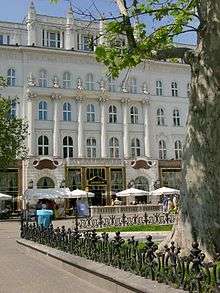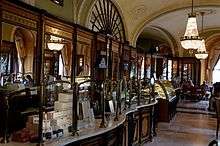Café Gerbeaud

Café Gerbeaud, situated at Vörösmarty tér 7 in Budapest, the capital of Hungary, is one of the greatest and most traditional coffeehouses in Europe. Today still, it shines in Gründerzeit style with its stucco, the grand chandeliers, the panelling made of exotic woods and its furniture. In 2009 Café Gerbeaud opened its second confectionery in Tokyo, Japan.[1]
History
The company was started in 1858 by Henrik Kugler, the third child of a confectionery dynasty. He acquired his knowledge and experience mostly during his journeymanship in eleven European capitals including Paris. After that he opened a confectionery at József nádor Square which was soon accounted for as one of the best in Pest. Among the specialities were Chinese and Russian tea specialities as well as his ice creations which were soon named “the best ice in Pest”.
In order to be closer to the city center, Kugler in 1870 moved the store to Vörösmarty tér. The customers of that time most favoured his coffees, liqueurs and candy. But Kugler Pies and Mignons were also well known, because for the first time it was possible to take them home, wrapped on a paper tray. Known guests were, among others, Ferenc Deák and Franz Liszt.
In 1882 while travelling Paris, Kugler first met Emil Gerbeaud and immediately recognized his talent and spirit of enterprise. 1884 Kugler finally invited him to Budapest to declare him to his associate. Later, Gerbeaud took over Kuglers store piece by piece and retained the original name.
Emil Gerbeaud, who was descended from a confectionery family, was born in Geneva and gained his experience in Germany, France and England. He performed a number of innovations, e.g. by expanding the selection with numerous products like butter creams, Parisian crèmes, hundreds of kinds of short cakes, candy and kirsch candy. To offer this broad palette to his clientele, he hired a number of employees for sales and service. By the end of 1899, he had about 150 employees, many of whom only came to Budapest to learn and work with Gerbeaud. Due to his sense of business, by and by he equipped the bakery with modern machinery. Thus, the name Gerbeaud became a Synonym for quality and bakery art. Since his clientele loved the paper boxes for takeaway pies that were already introduced by Henrik Kugler, Gerbeaud continued with this tradition and started to design these himself.
Gerbeaud was also internationally acclaimed. He was invited a jury member both to the Brussels world fair (1897) and the Paris world fair (1900), whereat in Paris he was awarded the Legion of Honour. He was further awarded numerous national and international prizes.
Eventually, Henrik Kugler died, whereupon Gerbeaud founded a public company named ‘Kuglers Nachfolger Gerbeaud AG’ (Kuglers Successor Gerbeaud PLC) to carry on the business. Since Gerbeaud set value on modern working conditions, he used automobiles alongside horse carriages from 1909 on.
 The confectionery
The confectionery One of the saloons
One of the saloons- Café Gerbeaud (inside)
For the interior design of his confectionery, Gerbeaud in 1910 took advice from Henrik Darilek who mainly used marble, exotic woods and bronze. The ceiling's stucco was created in the Rokoko style of Louis XIV of France. The chandeliers were inspired by Maria Theresa of Austria. The guests were offered as French tables as well as secessionist ones which Gerbeaud had delivered from the world fair in Paris. But World War I was felt but the company survived even that.
Gerbeaud died the 8th of November, 1919, and willed the store to his wife Ester who headed it until 1940. The shop retained the name “Gerbeaud” ever since, excepting the period between 1950 and March, 1984, when it was renamed “Vörösmarty”. In 1995, German businessman Erwin Franz Müller bought the confectionery and had it renovated extensively. The traces of the last 50 years have thus disappeared, and today the Café shines in the style as built by Emil Gerbeaud.
See also
References
External links
| Wikimedia Commons has media related to Café Gerbeaud. |
Coordinates: 47°29′49.25″N 19°3′1.50″E / 47.4970139°N 19.0504167°E